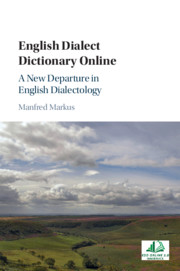Book contents
- English Dialect Dictionary Online
- English Dialect Dictionary Online
- Copyright page
- Contents
- Figures
- Tables
- Preface
- Acknowledgements
- Note on the Text
- 1 Introduction
- 2 Orthography
- 3 Tagging
- 4 The Syntax of EDD Entries, and How to Describe It
- 5 Some Practical Suggestions in Hindsight
- 6 The Interface
- 7 Retrieval Window (Advanced Mode)
- 8 Research Issues Encouraged by EDD Online
- 9 Focus on Quantification
- 10 Final Remarks on the Accessibility and Impact of EDD Online
- Appendix
- References
- Index
5 - Some Practical Suggestions in Hindsight
Published online by Cambridge University Press: 28 January 2021
- English Dialect Dictionary Online
- English Dialect Dictionary Online
- Copyright page
- Contents
- Figures
- Tables
- Preface
- Acknowledgements
- Note on the Text
- 1 Introduction
- 2 Orthography
- 3 Tagging
- 4 The Syntax of EDD Entries, and How to Describe It
- 5 Some Practical Suggestions in Hindsight
- 6 The Interface
- 7 Retrieval Window (Advanced Mode)
- 8 Research Issues Encouraged by EDD Online
- 9 Focus on Quantification
- 10 Final Remarks on the Accessibility and Impact of EDD Online
- Appendix
- References
- Index
Summary
The initial production of a double- or triple-text version, with one text created by a scanner and optical character recognition (OCR), the other (or rather two of them) by human (in our case, Chinese) typists, still seems to me to have been the optimal mode for the reliable digital reproduction of the text. The achievement of the Chinese typists was admirable. The automatic comparison of the human versions with our machine version, in the form of a ‘protocol’ of deviations, was a good foundation for our subsequent manual correction. Normal ‘manual’ proofreading of a text such as Wright’s EDD, the mode suggested in one of our earlier external expert reports, would have been practically impossible, given the small size of the fonts, the often confusing layout, the disconcerting and erratic spellings of dialect texts and the length of the Dictionary. We used this homemade mode of proofreading for the 179 pages of the Supplement, later added to the dictionary proper. In my view, our negative experience then confirmed the earlier assumption that Western readers/typists (rather than Chinese ones, with their strong sense of formal detail) may not have been able to do the job as satisfactorily. The text extract of Figure 5.1, from the entry of the verb and noun GO, may serve to illustrate this point of the EDD’s relative inaccessibility to typists.
- Type
- Chapter
- Information
- English Dialect Dictionary OnlineA New Departure in English Dialectology, pp. 23 - 34Publisher: Cambridge University PressPrint publication year: 2021

